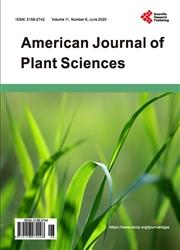Interaction Effect of Plant Growth Regulators on Shoot Micropropagation of Aromatic Plant Origanum elongatum (Bonnet) Emberger & Maire
引用次数: 0
Abstract
Origanum elongatum (Bonnet) Emb. & Maire, is a medicinal, aromatic and endemic plant of Morocco, characterized by its pharmacological effects, and is commonly used for the production of essential oils and aromas, resulting in high harvest and overexploitation pressure. This is why the present study aims to im-plement the in vitro micropropagation of Origanum elongatum for optimal vi-troplant production. Six macroelements were tested (SH, SD, N30K, MS, MSm and B5) and the SD medium was selected for vegetative propagation of the explants. Seven cytokinins: adenine (Ad), N6-(2-Isopentenyl) adenine, zeatin (Zeat), kinetin (Kin), benzyladenine (BAP), 1,3-diphenylurea (DPU) and thidiazuron (TDZ) were then evaluated at five concentrations (0.44, 1.33, 2.22, 3.11 and 4.44 µM/L) on growth, development, budding, rooting and hyperhydricity. 0.44 µM Kin was selected and combined with three auxins: indole-3-acetic acid (IAA), indole-3-butyric acid (AIB), and 1-naphthaleneacetic acid (NAA) at four concentrations (1.14, 2.85, 4.56 and 6.27 µM/L) to improve rooting and association with 1.14 µM IAA was shown to be efficient for roots development. Different concentrations of gibberellic acid (0.29, 1.5, 2.60 and 2.89 µM/L), combined with 0.44 µM/L Kin and 1.14 µM/L IAA, were tested and 2.60 µM/L GA 3 gave maximum buds and shoots. Then, the combination of three polyamines at five concentrations (1.134, 3.402, 5.67, 7.938 and 11.34 µM/L) with 0.44 µM Kin and 1.14 µM/L IAA showed an increase in the number of buds and shoots for 7.938 µM/L putrescine and 3.402 µM/L spermine. Finally, seedlings with good foliar and root development were acclima-tized.植物生长调节剂互作对芳香植物长柄鹤(Origanum elongatum, Bonnet) Emberger & Maire茎部微繁殖的影响
长形一枝花(帽状花序)& Maire,是摩洛哥的一种药用、芳香和特有植物,其特点是其药理作用,通常用于生产精油和芳香,导致高收获和过度开发压力。这就是为什么本研究的目的是实现长柄牛离体微繁,以获得最佳的体外培养植株。试验了6种常量元素(SH、SD、N30K、MS、MSm和B5),选择SD培养基进行外植体无性繁殖。以腺嘌呤(Ad)、N6-(2-异戊烯基)腺嘌呤、玉米素(Zeat)、动蛋白(Kin)、苄基腺嘌呤(BAP)、1,3-二苯脲(DPU)和噻唑脲(TDZ)为研究材料,分别在0.44、1.33、2.22、3.11和4.44 μ M/L浓度下对细胞分裂素的生长、发育、出芽、生根和高水化的影响。选择0.44µM Kin与3种生长素:吲哚-3-乙酸(IAA)、吲哚-3-丁酸(AIB)和1-萘乙酸(NAA)在1.14、2.85、4.56和6.27µM/L浓度下配用,可以促进生根,与1.14µM IAA配用有利于根系发育。以不同浓度的赤霉素酸(0.29、1.5、2.60和2.89µM/L)和0.44µM/L的Kin和1.14µM/L的IAA为对照进行试验,结果表明2.60µM/L的GA 3能产生最大芽和芽。3种多胺(1.134、3.402、5.67、7.938和11.34µM/L)与0.44µM Kin和1.14µM/L IAA组合处理后,7.938µM/L腐胺和3.402µM/L精胺的芽芽数和芽芽数均有所增加。最后,对叶片和根系发育良好的幼苗进行驯化。
本文章由计算机程序翻译,如有差异,请以英文原文为准。
求助全文
约1分钟内获得全文
求助全文

 求助内容:
求助内容: 应助结果提醒方式:
应助结果提醒方式:


